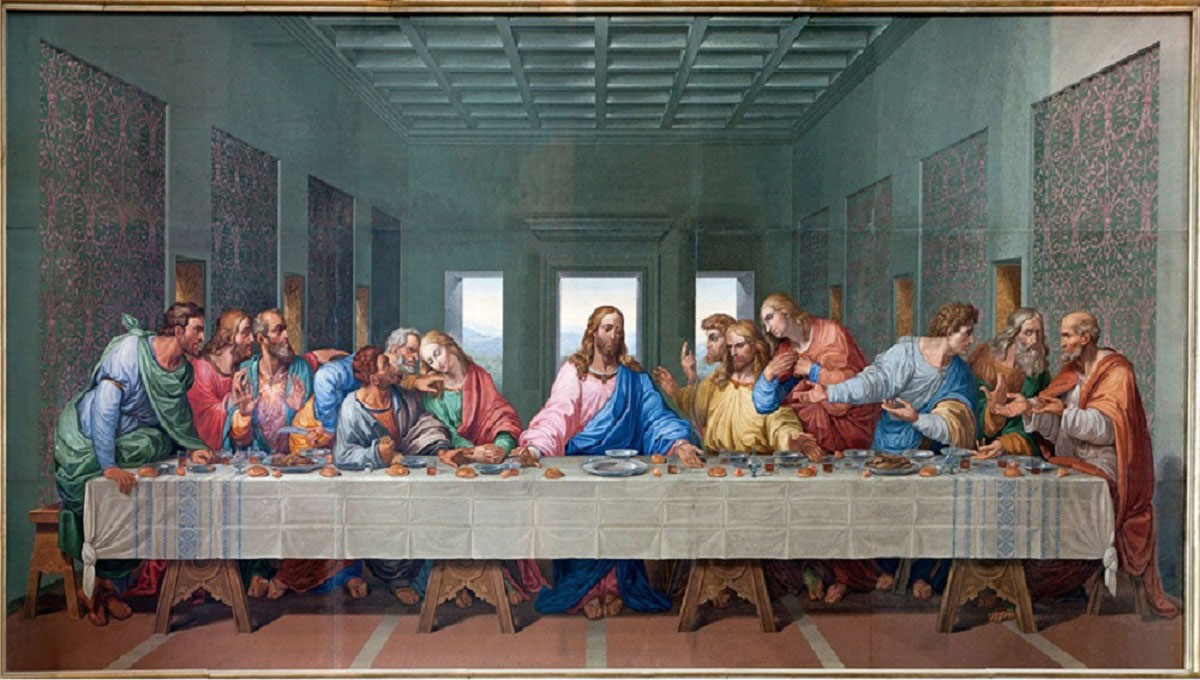
The work was commissioned by Ludovico Sforza, Duke of Milan, who was a patron of Leonardo in 1495 and it took the artist three years to complete. It is the greatest of many paintings depicting the last supper in the Bible’s New Testament: Jesus’ meal with his disciples during which he announces that one of them would betray him.
During the early Renaissance period, religion, particularly Christianity, commanded very great influence over works of art. Paintings of the last supper were not uncommon, yet Da Vinci’s depiction, from the moment it was finished in 1498 and throughout the centuries which followed, was declared a masterpiece, acclaimed by critics and artists alike. Many factors contributed to this, including that the painter himself was one of the greatest of the old masters of art. It also had to do with the way he worked and the effect it produced in the “Last Supper”. One of the reasons for the great acclaim is its commanding and dramatic detail of the occasion – Christ’s revelation and the way each of the apostles reacted to it. Every gesture, every facial expression is detailed to correspond to the character of each of the 13 men in the scene. It took so long to do because of Da Vinci’s particular way of working, including the way he searched around Milan studying faces to find the right model to use for each character.
Assistant Editor at Encyclopaedia Britannica Alicja Zelazko wrote about the “Last Supper’s” carefully drawn details. It depicts the dramatic scene described in “several closely connected moments in the Gospels, including Matthew 26:21–28, in which Jesus declares that one of the Apostles will betray him and later institutes the Eucharist”, she wrote. According to Da Vinci’s belief that posture, gesture, and expression should manifest the “notions of the mind,” each of the 12 disciples reacts in a manner that Da Vinci considered fit for that man’s personality. The result is a complex study of varied human emotion, rendered in a deceptively simple composition.
“The scene is not a frozen moment but rather a representation of successive moments. Jesus has declared his forthcoming betrayal, and the Apostles react. Philip, who stands in the group to Jesus’ left, gestures toward himself and seems to say, ‘Surely not I, Lord?’ Jesus seems to reply, ‘The one who has dipped his hand into the bowl with me will betray me’ (Matthew 26:23). Simultaneously, Jesus and Judas, who sits with the group to Jesus’ right, reach toward the same dish on the table between them, an act that marks Judas as the betrayer. Jesus also gestures toward a glass of wine and a piece of bread, suggesting the establishment of the Holy Communion rite,” she wrote.
This drama characterises the painting and elevates it from among many similar paintings on refectory walls of monasteries and convents, and the imitations that came after it. Da Vinci is the artist of a number of other paintings that have achieved equal fame and praise around the word over time. The “Mona Lisa” (1503) is revered among them and is another of the most recognisable among great paintings. No face is better known in any picture around the world than that of “La Giaconda” – another name given to the portrait because of its history. It is said to be a commissioned portrait of Lisa Gherardini, the wife of prominent merchant Francesco del Giocondo. Another is “Salvator Mundi” (1500) that was said to have set the record for the highest price paid for a painting in an auction. Note that this is another on the common Christian theme, focused as it is on the saviour of the world, although there is nothing common about it.
“Last Supper” has never failed throughout the 523 years since its creation, to be acknowledged as one of the best of all time, with praise also reportedly coming from fellow artists such as Rembrandt. Among the most treasured citations was one from exceptional writer Mary Wollstonecraft Shelley. She was the daughter of Mary Wollstonecraft who wrote a feminist treatise in 1797, wife of Romantic poet Percy Shelley and author of the extraordinary novel Frankenstein, a work of fiction well before its time. A genius herself, she recognised genius when she described her impressions on seeing the painting in “Ramblings in Germany and Italy” (1844).
“First we visited the fading inimitable fresco of Leonardo da Vinci. How vain are copies! Not in one, nor in any print, did I ever see the slightest approach to the expression in our Saviour’s face, such as it is in the original. Majesty and love – these are the words that would describe it – joined to an absence of all guile that expresses the divine nature more visibly than I ever saw it in any other picture.” (Mary Shelley, Travel Writing, retrieved from Wikipedia).
The painting has survived what Zelazko called “centuries of maltreatment” throughout the years, which contributed to deterioration in the original texture of the work. Note that in 1844 Shelley called it “the fading inimitable fresco”. It has undergone several restorations, especially just after World War II and in 1999, when the most extensive restoration work was done during which time the wall painting was closed from public view for 20 years.
So this masterpiece lives to proclaim the glory of art, and as a most worthy representative of Renaissance art and of the genius of an old master, the extraordinary Leonardo Da Vinci. This revisit of it might just appeal to celebrants of Easter, details of which the painting studies.






